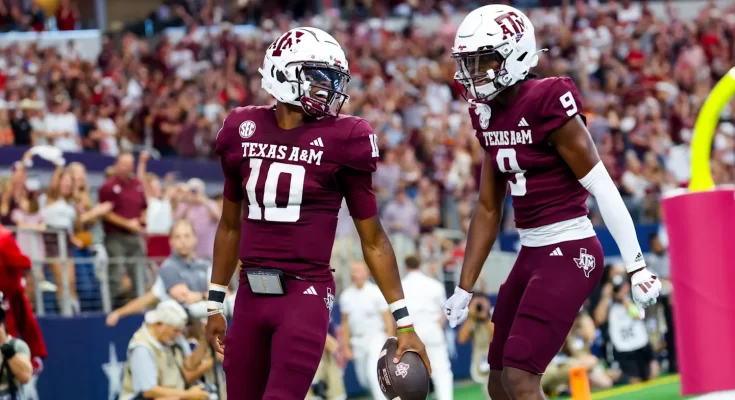Texas A\&M athletes collectively earned more than \$51 million in NIL deals during the 2024-25 season.
The landscape of college athletics has transformed dramatically over the past few years, and Texas A&M University has emerged as one of the leading examples of how the new era of Name, Image, and Likeness (NIL) compensation is reshaping opportunities for student-athletes. In the 2024-25 season, Texas A&M athletes received over $51 million in NIL deals, a staggering figure that underscores the power of the Aggies’ brand, the deep support from their alumni and local businesses, and the changing dynamics of collegiate sports. This milestone is not just about the money; it represents a broader shift in how athletes are valued, how universities approach recruitment and retention, and how the business of college athletics continues to evolve in ways that were once unimaginable.
When NIL legislation was first introduced in July 2021, few could have predicted just how quickly it would grow. What started as a way to allow athletes to profit from personal endorsements, social media campaigns, merchandise sales, and appearances has now become an integral part of college recruiting. Schools with strong fan bases, massive alumni networks, and supportive local economies have emerged as powerhouses in the NIL race. Texas A&M, with its storied history, passionate fan base, and robust athletic programs, was always poised to be a frontrunner. The $51 million figure from 2024-25 is proof of just how much the NIL landscape has accelerated, and it has firmly positioned Texas A&M as one of the most attractive destinations for high-profile athletes across the nation.
The $51 million total is not simply a reflection of one or two star athletes landing massive deals. It is spread across a wide range of sports and includes both men’s and women’s programs. While football naturally garners the largest share of NIL attention, other sports at Texas A&M—such as basketball, baseball, softball, soccer, track and field, and even less-publicized programs—are seeing meaningful benefits as well. This broader distribution of NIL money highlights a shift in how brands and businesses view student-athletes. Rather than focusing solely on Heisman hopefuls or future NBA stars, companies are recognizing the value of local engagement, niche audiences, and the authenticity that comes from partnering with athletes who have strong personal brands and loyal followings.
In football, Texas A&M’s NIL success is particularly noteworthy. The Aggies have consistently recruited top-tier talent, and NIL opportunities have become a major selling point. Players know that by choosing Texas A&M, they’re not just joining a competitive SEC program—they’re also stepping into one of the most lucrative NIL ecosystems in college sports. From car dealership sponsorships to energy companies and national brands, Texas A&M football players are seeing a level of financial support that not only rewards their hard work but also prepares them for the business side of professional athletics. It is no coincidence that the Aggies’ recruiting classes in recent years have been among the nation’s best, with NIL opportunities playing a key role in securing commitments from five-star prospects who might otherwise have leaned toward programs like Alabama, Georgia, or Ohio State.
But the NIL boom at Texas A&M goes far beyond football. Women’s sports have also seen a surge in opportunities, with standout athletes leveraging their social media presence, community connections, and personal stories to land deals with both local and national brands. For example, star players on the women’s basketball and softball teams have become influencers for apparel companies, fitness brands, and even local restaurants. The visibility that comes with playing in a competitive SEC environment, combined with Texas A&M’s large and passionate fan base, means that these athletes have platforms that rival some professional players in terms of reach and engagement. The $51 million total for 2024-25 represents not just an investment in star athletes but a recognition of the collective value of an entire athletic department.
One of the driving forces behind Texas A&M’s NIL success is the structured and proactive approach taken by the university and its network of supporters. While NCAA rules prohibit schools from directly paying athletes or arranging deals, they are allowed to provide education, resources, and connections that help athletes navigate the NIL world. Texas A&M has built a robust infrastructure that includes NIL education programs, legal and financial guidance, and partnerships with agencies that specialize in connecting athletes with brands. The school has also benefited from collectives—groups of alumni and boosters who pool resources to facilitate NIL deals for current athletes. These collectives ensure that athletes across multiple sports have access to opportunities, rather than allowing all the funding to funnel exclusively to high-profile football players.
The impact of this NIL windfall extends beyond the athletes themselves. Local businesses in College Station and the surrounding areas have found that partnering with Texas A&M athletes is a powerful way to connect with customers. Whether it’s a local BBQ joint teaming up with a football player for a social media campaign or a regional apparel brand featuring a basketball star in a promotional video, the collaborations have strengthened community ties and boosted local economies. The symbiotic relationship between athletes and businesses is one of the more positive aspects of the NIL era, as it creates a win-win scenario where both parties benefit financially and gain exposure.
However, the rapid growth of NIL compensation has not been without controversy or challenges. Critics argue that the system has created an uneven playing field, with wealthier programs like Texas A&M, Alabama, and USC having a clear advantage over smaller schools that lack the same financial backing. There are also concerns about the potential for NIL deals to overshadow the traditional values of college athletics, where scholarships, education, and team pride were once the primary motivators. For some, the fear is that college sports could morph into a professional-like free agency system, where athletes make decisions based primarily on financial incentives rather than athletic fit or academic opportunities. Texas A&M’s $51 million figure will likely fuel these debates even further, as it illustrates just how lucrative the NIL market has become for top-tier programs.
For the athletes, though, the NIL era has opened doors that were previously locked. Before 2021, student-athletes were prohibited from profiting off their personal brands, even as their schools, conferences, and the NCAA made billions in revenue. The shift to allow NIL compensation is widely seen as a step toward fairness, giving athletes the ability to capitalize on their hard work, talent, and popularity. For many Texas A&M athletes, the income they’ve earned from NIL deals in 2024-25 will provide financial security, allow them to support their families, and give them a head start on life after sports. Some have even launched entrepreneurial ventures, using NIL earnings to start businesses or invest in personal projects.
The educational component of NIL is also critical. Texas A&M has been proactive in ensuring that athletes understand how to manage their newfound income, pay taxes, and plan for the future. Financial literacy programs, mentorship from former athletes, and partnerships with legal experts have helped Aggies navigate the complexities of endorsement contracts and personal branding. This emphasis on education ensures that NIL is not just about short-term gains but also about long-term success for the athletes involved.
Looking ahead, Texas A&M’s $51 million NIL milestone may just be the beginning. As the market matures, deals are likely to become even more sophisticated, with brands investing in long-term partnerships, digital content creation, and unique fan experiences. Universities like Texas A&M that have embraced NIL from the outset are well-positioned to thrive in this evolving landscape. Their ability to attract and retain top talent, both on and off the field, will be closely tied to how effectively they can leverage NIL opportunities.
Moreover, the success of Texas A&M athletes in securing such a high level of NIL compensation will likely have a ripple effect across college athletics. Other schools will study their approach, looking to replicate the strategies that have made the Aggies so successful. Conferences may explore new policies or partnerships to ensure that NIL opportunities are equitable and sustainable. The NCAA, which has struggled to regulate NIL in its early years, may face increased pressure to establish clearer guidelines, particularly as the gap between NIL-rich programs and others continues to widen.
The 2024-25 NIL earnings of over $51 million for Texas A&M athletes is more than just a statistic. It’s a reflection of a new era, one in which college athletes are finally able to see the financial rewards of their labor and visibility. For Texas A&M, it’s also a statement of intent—a demonstration that the Aggies are committed to leading the charge in the NIL era, using their resources, fan support, and innovative strategies to create a winning formula on and off the field. While debates about the future of NIL will continue, there’s no denying that Texas A&M’s success in this area has set a benchmark for what’s possible in college athletics.



